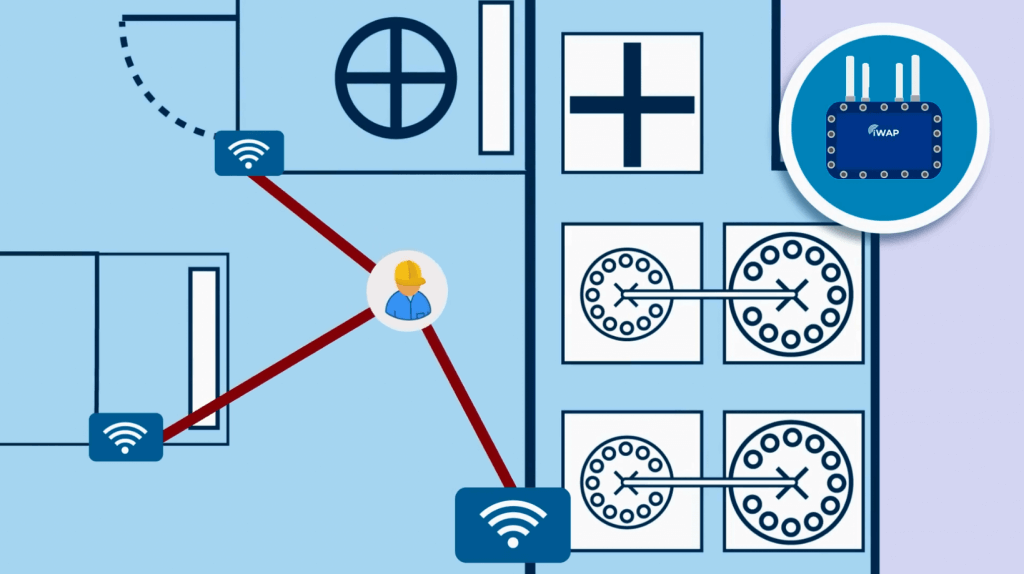Received signal strength indication (RSSI) location principle utilizes received signal strength to establish the location of the transmitting device.

Image Credit: Extronics Ltd
A wireless device emits a signal and that signal is received by an access point or gateway. Multiple access points will collect the signal and results in the received signal strength being established by each access point.
The greater the distance between the access point and the transmitting device, the weaker the signal. Comparatively, the closer the device transmitting signal is to an access point, the stronger the strength of the signal being received.
The precise location is decided by receiving the signal from several access points and calculating the various measurements to determine an approximation of location, a process technically known as triangulation or trilateration.
Therefore, the approximate location can be suitably positioned on a map. For instance, an asset or a worker wearing a Wi-Fi RTLS tag can be easily and precisely located using this method.
Wi-Fi Triangulation – Indoor vs. Outdoor
All radio technology, including BLE, have to endure the same fundamental issue – signal strength is not linear to distance. This is particularly true considering distances over fifteen to twenty meters.
At this range, there is an exponential drop-off in signal strength; a weakened signal strength can lead to a ten- or twenty-meter shift in location accuracy.
The challenge with RSSI is the aggregate sum of infrastructure required to maintain sub-ten-meter accuracy.
Built up or indoor processing areas tend to have an advantage over larger outdoor areas when utilizing the RSSI location principle. For instance, walls between different rooms assist and offer significant differences in signal strength. Thus, the signal strength received by the access point will be much stronger in the room where the transmitting device is located in contrast to other rooms.

Image Credit: Extronics Ltd
The Added Cost of Wi-Fi Infrastructure
However, the same cannot be said for outdoor environments. To sustain a good level of accuracy, using Wi-Fi triangulation necessitates a vast investment.
Sub-ten-meter location accuracy would need an access point to be situated every twenty to twenty-five meters. When you contemplate the size of a facility such as a refinery, a tank farm, or a large petrochemical plant, then this would lead to the potential installation of thousands of access points.
The cost alone of installing such a large number of access points is considerably high, particularly when the consideration is made that many areas are hazardous environments. This would necessitate the use of certified enclosures, long cable runs, and the associated installation costs that comes with the work.
Reducing the Need for Dense Wi-Fi with Hybrid Technology
RSSI location is an ideal solution in areas where you would normally observe high-concentrations of Wi-Fi, such as on dense metal infrastructure on processing plants. Typically, these areas require an access point every twenty meters to guarantee the appropriate connectivity for various Wi-Fi devices, including tablets.
A hybrid solution facilitates the use of multiple location technology. In large outdoor environments, GPS can be utilized to sustain location accuracy. In these scenarios, Wi-Fi is only used for GPS location data backhaul, and there is no requirement that necessitates the positioning of access points every twenty meters. This method considerably reduces the level of Wi-Fi infrastructure needed for precisely locating personnel or assets in outdoor environments.
For full functionality of site-wide Industrial Internet of Things (IoT), the connectivity required for RTLS requirements should be taken into consideration. Moreover, additional uses of wireless networking, such as other sensor backhaul, data connectivity, ePermitting, video collaboration, or applications like VOIP, should also be reviewed.
Conclusion
To ensure sub-ten-meter location accuracy across an entire site using RSSI is achieved would necessitate a dense wireless network. RSSI is typically well-suited to built-up or indoor environments where you tend to observe dense Wi-Fi infrastructure for various connectivity reasons. Yet, to sustain an adequate level of accuracy in large outdoor spaces, generally found in processing plants, including refineries and petrochemical works, would need considerable capital investment. Hybrid technology offers a more cost-effective system that accomplishes a high degree of accuracy, no matter where you are on site.

This information has been sourced, reviewed and adapted from materials provided by Extronics Ltd.
For more information on this source, please visit Extronics Ltd.